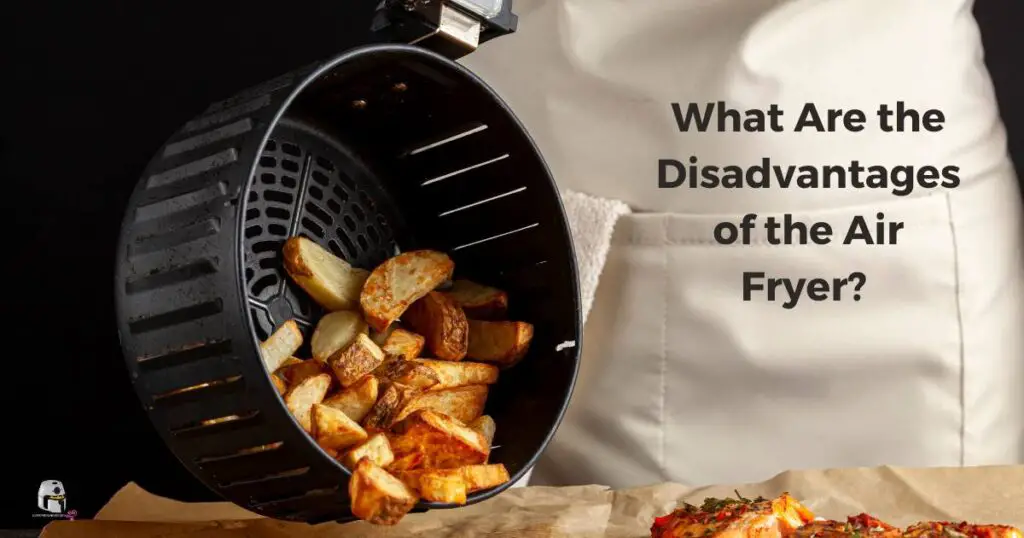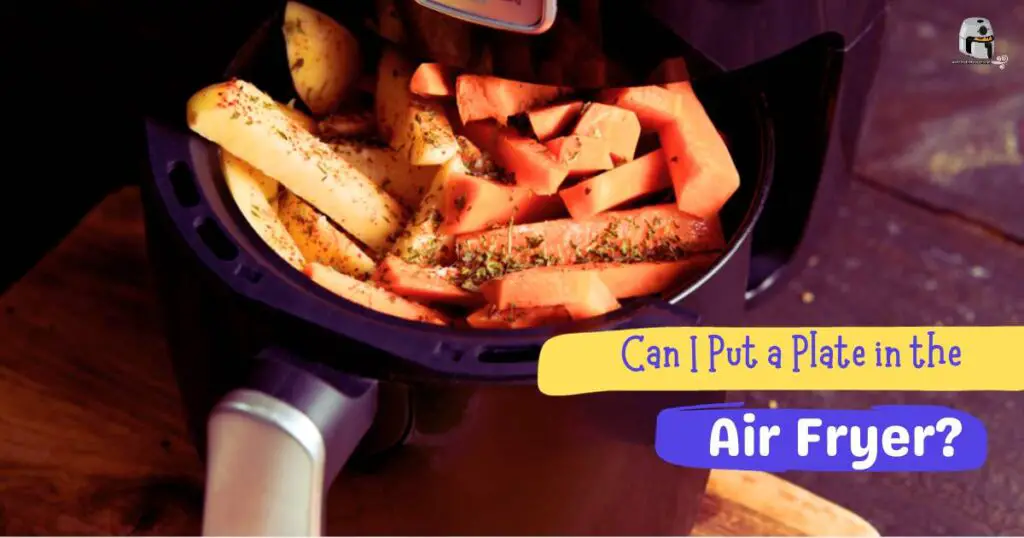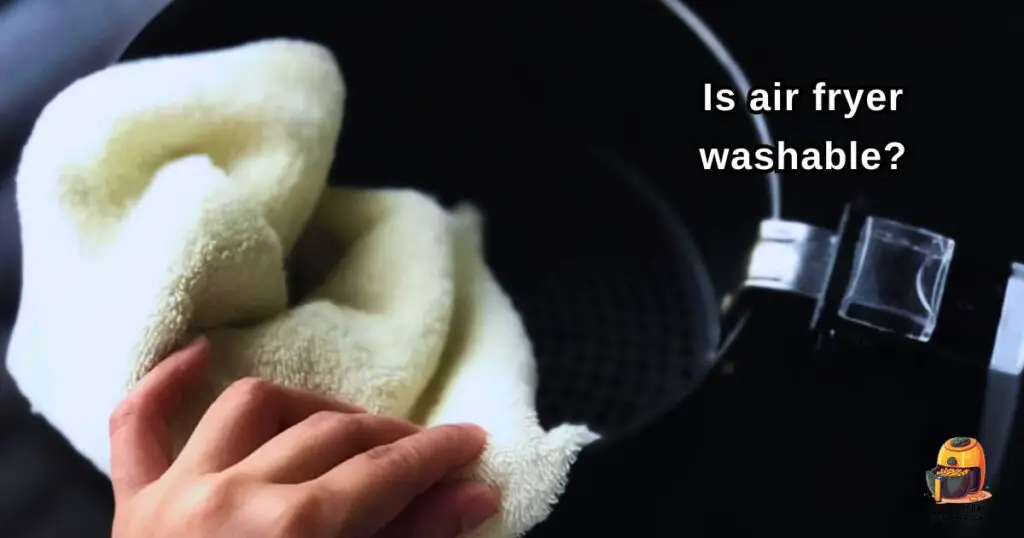Table Of Contents
Air fryers, despite their numerous advantages, do come with a set of drawbacks. Firstly, their limited capacity may not be suitable for preparing large meals or serving a crowd. While they use less oil, the taste and texture of air-fried food may not precisely replicate traditional deep frying.
Some models can be quite noisy during operation, potentially disrupting a peaceful kitchen atmosphere. Cleaning can also be a chore, especially with models featuring numerous components. Lastly, air fryers occupy countertop space, which might pose challenges in smaller kitchens.
Despite these downsides, their ability to create healthier versions of fried dishes often outweighs these limitations for many users.
Let’s discuss the disadvantages of the air fryer.

What Are the Disadvantages of the Air Fryer
Certainly, let’s delve into more detail about the disadvantages of air fryers:
Limited Cooking Capacity
The cooking basket or tray in most air fryers is relatively small, which can be a drawback when you want to prepare meals for a larger family or group. You may need to cook in batches, which can be time-consuming.
Not Ideal for Certain Foods
Air fryers excel at producing a crispy exterior, but they may not be the best choice for dishes that rely on a moist or soft interior. Foods like soups, stews, or dishes with delicate textures may not turn out as expected in an air fryer.
Learning Curve
While air fryers are relatively simple to use, achieving perfect results may require some trial and error, especially when adapting traditional recipes. Understanding the right temperature, cooking time, and amount of oil to use can take some practice.
Can Produce Dry Results
If you’re not careful with your cooking times and oil usage, air fryers can sometimes produce dry or tough results. Overcooking or not using enough oil can be common pitfalls.
Noise
Some air fryer models can be noisy during operation, which might be a concern in quieter environments, especially if you prefer a peaceful cooking experience.
Initial Cost
Air fryers can be relatively expensive upfront compared to other kitchen appliances like microwave ovens or toaster ovens. While they may save you money in the long run by reducing oil usage, the initial investment can be a deterrent.
Takes Up Counter Space
The size of air fryers can vary, but many models can take up a significant amount of counter space in your kitchen. This can be a concern if you have a small kitchen with limited workspace.
Regular Maintenance
Like any kitchen appliance, air fryers require regular cleaning and maintenance to ensure they function properly. This includes cleaning the cooking basket, tray, and any removable parts after each use.
When considering an air fryer, it’s essential to weigh these disadvantages against the benefits and decide if this appliance aligns with your cooking style and kitchen space.
How to choose the right air fryer
Choosing the right air fryer involves several considerations to ensure it meets your cooking needs and preferences. Here’s a step-by-step guide to help you make an informed decision:
1. Determine Your Cooking Needs
Assess the types of dishes you plan to cook in your air fryer. Are you mainly interested in preparing snacks, roasting vegetables, or cooking complete meals? Understanding your specific cooking needs will help narrow down your options.
2. Capacity
Consider the size of the air fryer’s cooking basket. If you often cook for a larger family or group, opt for a larger capacity model (typically 5-6 quarts or more). Conversely, if you have a smaller household, a compact size (around 3-4 quarts) may suffice.
3. Cooking Power
Check the wattage of the air fryer. Higher wattage generally means quicker and more even cooking. However, keep in mind that higher-wattage appliances may consume more electricity.
4. Temperature Range
Ensure that the air fryer offers a temperature range suitable for your cooking needs. Most models have a temperature range of 180°F to 400°F, but some premium models offer even higher temperatures, which can be advantageous for specific recipes.
5. Cooking Functions
Explore whether you want an air fryer with additional cooking functions such as roasting, baking, grilling, or dehydrating. These versatile models can replace multiple kitchen appliances, saving space and simplifying your cooking.
6. User-Friendly Interface
Examine the control panel and interface. Confirm that it is user-friendly and provides precise temperature and time settings. Digital displays are often more accurate and user-friendly than manual dials.
7. Pre-Programmed Settings
Some air fryers come equipped with pre-programmed settings for common dishes like French fries, chicken, and seafood. These settings can simplify cooking, but they are not essential if you prefer manual control over your cooking process.
8. Cleaning and Maintenance
Consider the ease of cleaning. Look for air fryers with removable, dishwasher-safe parts and non-stick coatings, which can significantly simplify cleanup after cooking.
9. Brand and Model Reputation
Research the reputation of the brand and specific model. Reading customer reviews and assessing overall satisfaction and durability can provide valuable insights into the appliance’s performance and reliability.
10. Price and Budget
Set a budget for your air fryer purchase. While there are affordable options available, premium models with advanced features may come at a higher cost. Ensure that your chosen air fryer aligns with your budget.
11. Additional Features
Explore additional features such as a built-in timer, auto-shutoff function, or a Keep Warm feature. These functionalities can add convenience to your cooking experience.
12. Warranty and Customer Support
Check the warranty and customer support offered by the manufacturer. A longer warranty period can provide peace of mind, and reliable customer support can be beneficial if you encounter any issues.
13. Size and Storage
Ensure that the air fryer fits comfortably on your kitchen countertop and has sufficient ventilation space around it during operation. Additionally, consider whether you have ample storage space when the appliance is not in use, as some air fryers can be bulky.
By considering these factors and weighing your priorities, you can choose the right air fryer that aligns with your cooking style and kitchen requirements.
How to Use an Air Fryer Safely and Effectively
Using an air fryer safely and effectively is crucial to achieving the best cooking results while minimizing potential risks. Here’s a comprehensive guide on how to do so:
1. Read the Manual Thoroughly
Begin by carefully reading the manufacturer’s manual that accompanies your air fryer. This document provides vital safety guidelines, usage instructions, and maintenance tips for your appliance.
2. Choose the Right Location
Place the air fryer on a stable, level, and heat-resistant surface. Avoid using it near water sources or flammable materials. Ensure there’s adequate clearance around the appliance for proper ventilation.
3. Preheat the Air Fryer
Many recipes benefit from preheating the air fryer. Follow the recommended preheating time and temperature stated in the manual or recipe for more consistent cooking results.
4. Use the Correct Cookware
Always use cookware that is compatible with your air fryer. Typically, this means using the provided Basket or tray. Avoid using materials like aluminum foil or glass cookware unless the manual explicitly states they are safe to use.
5. Avoid Overcrowding
Do not overcrowd the cooking basket or tray with food. Overcrowding can obstruct air circulation, leading to uneven cooking. Cook in batches if necessary to maintain proper airflow.
6. Brush or Spray with Oil
While air frying is known for using less oil, some foods benefit from a light oil coating to enhance crispiness. Use a brush or an oil sprayer to apply a thin layer of oil to your ingredients before cooking.
7. Monitor Cooking Progress
Keep a close eye on your food as it cooks. This allows you to check for doneness and make any necessary adjustments to prevent overcooking or burning.
8. Use Oven Mitts or Heat-Resistant Gloves
When handling the air fryer’s Basket or tray after cooking, always use oven mitts or heat-resistant gloves. The interior and accessories can become extremely hot during the cooking process.
9. Be Cautious with Wet Batters
If you’re air frying items with wet batters (such as battered fish or chicken), make sure to shake off excess batter. Wet batters can drip and cause smoking or sticking during cooking.
10. Cleaning and Maintenance
Clean the air fryer thoroughly after each use, following the manufacturer’s instructions. Ensure that all parts are completely dry before storing to prevent mold growth or odors.
11. Avoid Blocking Ventilation
Ensure that the air fryer’s ventilation openings are not obstructed during operation. Obstructions can hinder proper air circulation and potentially lead to overheating.
12. Safety Disconnect
In the event of any malfunctions, strange noises, or unusual behaviors during cooking, immediately disconnect the air fryer from the power source and refrain from using it until the issue is resolved. Contact customer support if necessary.
13. Experiment and Learn
Familiarize yourself with your specific air fryer’s settings and cooking times. Experiment with different recipes and ingredients to become more proficient in using your appliance effectively.
By following these detailed safety and usage guidelines, you can confidently and safely use your air fryer while enjoying delicious, well-cooked meals.
Common Air Fryer Problems and How to Solve Them
Air fryers are generally reliable kitchen appliances, but like any other device, they can encounter issues. Here are some common air fryer problems and solutions:
1. Food Not Getting Crispy
Problem: If your food isn’t getting crispy, it may be due to Overcrowding in the cooking basket or using a wet batter that’s too thick.
Solution: Ensure you leave space between food items in the Basket to allow for proper air circulation. Shake or flip the food during cooking to promote even crisping. For items with wet batters, try thinning the batter.
2. Food Sticking to the Basket
Problem: Food sticking to the Basket can be frustrating and may result in a messy cleanup.
Solution: Use a light coating of cooking spray or a small amount of oil on the food or the Basket’s surface to prevent sticking. Alternatively, consider using parchment paper or silicone liners for certain items.
3. Uneven Cooking
Problem: Unevenly cooked food can be disappointing, with some parts overcooked while others remain undercooked.
Solution: Arrange food items evenly in the Basket, avoiding Overcrowding. Some air fryers have a rotating basket or tray; if yours does, use it to ensure even cooking. You can also pause cooking to shake or rearrange food for uniform results.
4. Smoke or Odor
Problem: Excessive smoke or lingering odors can occur due to excess oil or food residue.
Solution: Thoroughly clean your air fryer after each use to prevent residue buildup. Consider using a drip tray or foil to catch drips. Also, ensure you use oil with a suitable smoke point for high-temperature cooking.
5. Error Codes or Malfunctions
Problem: It can be concerning if your air fryer displays error codes or malfunctions.
Solution: Consult your air fryer’s manual for specific error code meanings and troubleshooting steps. A common solution is to unplug the appliance, wait a few minutes, and then plug it back in to reset it. If the issue persists, contact customer support or seek professional repair.
6. Food Overcooking or Burning
Problem: Overcooked or burnt food can result from setting incorrect temperatures or cooking times.
Solution: Monitor cooking times closely, especially when trying new recipes. Lower the temperature or reduce cooking time as needed. Familiarize yourself with your air fryer’s presets if it has them.
7. Noisy Operation
Problem: Some air fryers can be noisy during operation due to the fan and heating element.
Solution: Ensure the air fryer is placed on a stable surface to minimize vibrations. If you notice unusual or excessively loud noise, contact customer support.
8. Strange Smells
Problem: Unpleasant or strange odors can develop inside the air fryer over time.
Solution: Regularly clean removable parts like the Basket and tray after each use. Run a cleaning cycle with a mixture of water and vinegar to eliminate lingering smells.
9. Timer or Temperature Inaccuracies
Problem: If your air fryer’s timer or temperature settings are inaccurate, it can lead to poorly cooked food.
Solution: Verify the air fryer’s accuracy by using an oven thermometer or separate timer. If you notice significant discrepancies, contact customer support for potential calibration or repair.
10. Food Drying Out
Problem: Food can sometimes dry out during air frying, leading to less appealing results.
Solution: To prevent food drying, consider brushing a small amount of oil on the surface before cooking. You can also use a basting brush to apply oil or sauce during cooking to keep the food moist.
Remember to consult your air fryer’s manual for model-specific troubleshooting guidance and follow the manufacturer’s cleaning and maintenance recommendations to prevent common problems from arising.
FAQs
Is an Air Fryer a Waste of Money?
No, an air fryer is not a waste of money. While it’s an investment, it offers healthier cooking, versatility, and efficiency. If you value these benefits and use them regularly, it can be a worthwhile addition to your kitchen, saving you time and promoting healthier eating habits.
Do Chefs Hate Air Fryers?
Not all chefs hate air fryers, but opinions vary. Some chefs appreciate the speed and convenience they offer for certain tasks. However, others may prefer traditional cooking methods for precise control and depth of flavor, leading to mixed sentiments among culinary professionals.
Final Verdict
In summary, air fryers are versatile and advantageous kitchen appliances. Still, they do have drawbacks, including limited cooking capacity, the potential for food texture differences, operational noise, cleaning complexities, and countertop space usage. However, these downsides are often outweighed by health benefits like reduced oil usage and the convenience of quick, delicious meals.
To maximize your air fryer, choose the right size, explore extra functions, and prioritize easy cleaning. When used effectively, it becomes a valuable kitchen addition, offering healthier cooking options and convenience.


